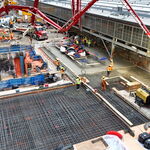futurebound
New Member
highways don't break even? unless you toll highways it's impossible to break even.You can also see it the other way.
Highway = much cheaper to build, gives door to door access, breaks even very easily
Train = much more costly to build, needs a lot more people to break even
Both highways and trains are right in their own places and both can't replace the other.
PS - urban trains don't make money and no one expects them to.
highways and trains are public services, they shouldn't be expected to be profitable/break even.




